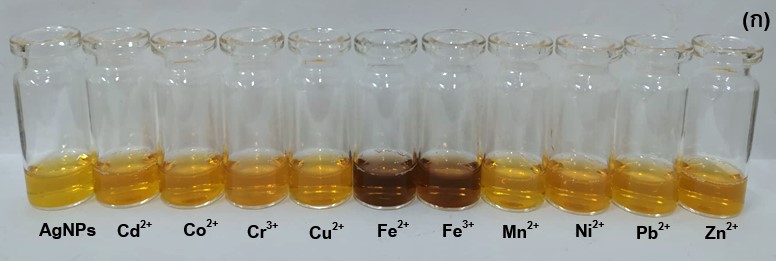การสังเคราะห์และประยุกต์ใช้อนุภาคนาโนเงินที่ดัดแปลงพื้นผิวชนิดใหม่สำหรับการวิเคราะห์เหล็ก (III) ในตัวอย่างน้ำเสีย
Main Article Content
Abstract
Piyada Jittangprasert, Dhanapat Kerdkok and Pan Tongraung
รับบทความ: 27 มีนาคม 2563; แก้ไขบทความ: 8 มิถุนายน 2563; ยอมรับตีพิมพ์: 12 มิถุนายน 2563
บทคัดย่อ
ในงานวิจัยนี้ได้พัฒนาและสังเคราะห์อนุภาคนาโนเงินชนิดใหม่ที่ดัดแปลงพื้นผิวโดยใช้สารเพิ่มความคงตัวร่วมกัน (CT–EDTA–L–TA–AgNPs) เพื่อใช้เป็นเซ็นเซอร์สำหรับการวิเคราะห์ปริมาณเหล็ก (III) จากผลการศึกษาความจำเพาะเจาะจงระหว่าง CT–EDTA–L–TA–AgNPs กับไอออนบวกชนิดต่าง ๆ ได้แก่ แคดเมียม (II) โครเมียม (III) คอปเปอร์ (II) เหล็ก (II) เหล็ก (III) แมงกานีส (II) นิกเกิล (II) ตะกั่ว (II) และสังกะสี (II) พบว่า อนุภาคนาโนเงินนี้มีความจำเพาะเจาะจงต่อไอออนของเหล็ก (III) มากกว่าไอออนบวกชนิดอื่น ๆ โดยสารละลายเปลี่ยนจากสีเหลืองเป็นสีน้ำตาลเข้ม เมื่อนำอนุภาคนาโนเงินที่สังเคราะห์ได้มาประยุกต์ใช้สำหรับวิเคราะห์ปริมาณเหล็ก (III) พบว่า ให้กราฟมาตรฐานที่เป็นเส้นตรงในช่วงความเข้มข้นตั้งแต่ 0.40–100 มิลลิกรัมต่อลิตร (r2=0.9988) มีค่าขีด-จำกัดต่ำสุดที่ตรวจวัดได้ (LOD) เท่ากับ 0.10 มิลลิกรัมต่อลิตร และค่าขีดจำกัดต่ำสุดของการวิเคราะห์ปริมาณ (LOQ) เท่ากับ 0.40 มิลลิกรัมต่อลิตร วิธีที่พัฒนาขึ้นนี้สามารถนำไปประยุกต์ใช้ในการวิเคราะห์น้ำเสียจากโรงงานอุตสาหกรรมยานยนต์ได้เป็นผลสำเร็จและให้ผลการวิเคราะห์ที่สอดคล้องเป็นอย่างดีกับผลการวิเคราะห์ด้วยเทคนิคอะตอมมิกแอบซอร์พชันสเปกโทรสโกปี
คำสำคัญ: อนุภาคนาโนเงินที่ดัดแปลงพื้นผิว เหล็ก (III) น้ำเสีย สารเพิ่มความคงตัวร่วมกัน
Abstract
In this research, novel modified silver nanoparticles using co-stabilizing agents (CT–EDTA–L–TA–AgNPs) were developed and synthesized as colorimetric sensor for determination of iron (III). The selectivity of CT–EDTA–L–TA–AgNPs with various cations, such as Cd(II), Cr(III), Cu(II), Fe(II), Fe(III), Mn(II), Ni(II), Pb(II) and Zn(II) were carried out. The results indicated that synthesized silver nanoparticles showed high selectivity for iron (III) over other cations. The color of a solution obviously turned from yellow to dark brown. The CT–EDTA–L–TA–AgNPs–based colorimetric sensor was then applied for determination of iron (III). The results showed that a linear calibration curve was obtained over the concentration range of 0.40–100 mg/L with good correlation coefficients (r2=0.9988). The limit of detection (LOD) was 0.10 mg/L and the limit of quantitation (LOQ) was 0.40 mg/L. The developed method was successfully applied for quantitative analysis of iron (III) in wastewater from automotive factory. The results were in good agreement with those obtained by the Atomic Absorption Spectroscopy.
Keywords: Modified silver nanoparticles, Iron(III), Wastewater, Co–stabilizing agents
Downloads
Article Details

This work is licensed under a Creative Commons Attribution-NonCommercial 4.0 International License.
References
Azimpanah, R., Solati, Z., and Hashemi, M. (2018). Green synthesis of silver nanoparticles and their applications as colorimetric probe for determination of Fe3+and Hg2+ions. IET Nanobiotechnology 12(5): 673–677.
Bag, H., Turker, A. R., and Lale, M. (2000). Determination of Cu, Zn, Fe, Ni and Cd by flame atomic absorption spectrophotometry after preconcentration by Escherichia coli immobilized on sepiolite. Talanta 51: 1035–1043.
Basiri, S., Mehdinia, A., and Jabbari, A. (2018). A sensitive triple colorimetric sensor based on plasmonic response quenching of green synthesized silver nanoparticles for determination of Fe2+, hydrogen peroxide, and glucose. Colloids and Surfaces A: Physicochemical and Engineering Aspects 545: 138–146.
Beyene, H. D., Werkneh, A. A., Bezabh, H. K., and Ambaye, T. G. (2017). Synthesis pa-radigm and applications of silver nanoparticles (AgNPs), a review. Sustainable Materials and Technologies 13: 18–23.
Blatny, P., Kvasnlcka, F., and Knndler, E. (1997). Trace determination of iron in water at the ug level by on–line coupling of capillary isotachophoresis and capillary zone electrophoresis with UV detection of the EDTA–Fe(III) complex. Journal of Chro-matography A 757: 297–302.
Gao, X., Lu, Y., He, S., Li, X., and Chen, W. (2015). Colorimetric detection of iron ions (III) based on the highly sensitive plasmonic response of the N–acetyl–L–cys-teine stabilized silver nanoparticles. Analytica Chimica Acta 879: 118–125.
Hem, J. D., and Cropper, W. H. (1962). Chem-istry of Iron in Natural Water. Washing-ton, DC: United States Government Publishing Office. Retrieved from https://www.sciencedirect.com/science/article/pii/B97 80444641106000494?via%3Dihub, May 21, 2019.
Mao, J., He, Q., and Liu, W. (2010). An rhodamine–based fluorescence probe for iron (III) ion determination in aqueous solution. Talanta 80(5): 2093–2098.
Masawat, P. (2011). Determination of iron(II) in natural waters using the developed microvolume autotitrator. NU Science Journal 8: 37–53. (in Thai)
Mohamed, K. N., and Gledhill, M. (2015). De-termination of specific iron chelator by us-ing LC–ICP–MS and LC–ESI–MS. Pro-cedia Environmental Sciences 30: 256–261.
Nayab, P. S., and Shkir, M. (2017). Rapid and simultaneous detection of Cr(III) and Fe (III) ions by a new naked eye and fluorescent probe and its application in real samples. Sensors and Actuators B: Chemical 251: 951–957.
Promsorn, T. (2014). Iron Removal in Water with Calcium Hydroxyapatite. Bangkok: Dhurakij Pundit University.
Roto, R., Marcelina, M., Aprilita, N. H., Mudasir, M., Natsir, T. A., and Mellisani, B. (2017). Investigation on the effect of ad-dition of Fe3+ ion into the colloidal AgNPs in PVA solution and understanding its re-action mechanism. Indonesian Journal of Chemistry 17(3): 439–445.
Salavati–Niasari, M., and Bazarganipour, M. (2009). Synthesis, characterization and alcohol oxidation properties of multi–wall carbon nanotubes functionalized with a cobalt(II) Schiff base complex. Transition Metal Chemistry 34: 605–612.
Samerjai, W. (2018). Chemosensor of Iron Detection Using 4–Aminothiophenol and Naphthalene–2–ol Derivative Modified Silver Nanoparticles. Master of Education Thesis (Chemistry).Bangkok: Srinakharinwirot University. (in Thai)
Sobkowiak, M., Gabrielsson, R., Inganäs, O., and Milczarek, G. (2014). Amperometric detection of iron (III) on electroconductive hydrogel based on polypyrrole and alko xysulfonated poly(3,4–ethylenedioxythiophene) (PEDOT–S). Synthetic Metals 194: 170–175.
Verma, C., Tapadia, K., and Soni, A. B. (2017). Determination of iron(III) in food, biological and environmental samples. Food Chemistry 221: 1415–1420.
Vinod, K. V., and Anthony, S. P. (2014). Silver nanoparticles based selective colorimetric sensor for Cd2+, Hg2+ and Pb2+ ions: Tuning sensitivity and selectivity using co–stabilizing agents. Sensors and Actuators B: Chemical 191: 31–36.
Wei, J., Chen, J., Yue, G., Hu, L., Zhao, D., Zhu, J., and Zhao, P. (2018). Development of a novel tridentate ligand for colorimetric detection of Mn2+ based on AgNPs. Spectrochimica Acta Part A: Molecular and Biomolecular Spectroscopy 202: 244–251.
Zhou, Y., Zhao, H., Li, C., He, P., Peng, W., Yuan, L., Zeng, L., and He, Y. (2012). Colorimetric detection of Mn2+ using silver nanoparticles cofunctionalized with 4–mercaptobenzoic acid and melamine as a probe. Talanta 97: 331–335.
